
The idea of completing a two day hike across Continental Europe’s longest Glacier came from two guests who announced to me at a welcome meeting one day, that they were planning on complete the journey with the folk at Grindelwald Sports. I wandered down to with them to assist with finalising the last minute details and to my delight found that there was a chance for me to join a group making the hike a week later! The hike is suitable for anyone who is physically fit and able to manage two days of walking with poles at an altitude above 3000m, along with the occasional jump to clear a crevasse. I was completely hooked but it would still depend on the weather being right. So for the next week I watched every forecast with absolute trepidation. With the forecast varying wildly for the day of our departure I called the office the morning before the hike and nervously asked if it was still going ahead? ‘We don’t know yet’ she said, but we’ll call you when he have another forecast. I was on tenterhooks until finally, in the early afternoon my phone went to say that they’d decided the weather was good enough and we’d all be meeting at Kleine Schiedegg at 10.00am. That evening I was faced with the dilemma of what to pack in my backpack. With water, energy snacks and lunch for two days as well as waterproofs, layers, the highly recommended change of socks and other essentials plus phone charger, walking poles, my climbing harness and the GoPro camera that John, one of my colleagues had kindly agreed to lend me, I decided that I was good to go!
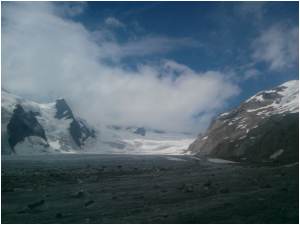 Arriving early at Kleine Schiedegg, I explored and found the carriage reserved for our Gletscherwanderung on the red Jungfraubahn train. A few minutes later the next train from Grindelwald pulled in and I was joined by the rest of our party, accompanying Lorenz our bergfuhrer laden down with ropes, harnesses, walking poles and crampons, the essentials of a glacier hike. Everyone else in this trip turned out to be Swiss or German so I quite quickly realised that my basic Deutsch was going to be stretched, however during our ride up the incredible engineering feat of the Jungfraubahn within the heart of the Eiger and Monch mountains, I found that everyone was patient with my hesitant German and had enough English to help me when I struggled. For a number of the party, this was the first time at The Top of Europe so we agreed on taking a swift tour of the essentials with a trip to the Sphinx to look out over the huge expanse of the Aletsch and its’ tributary glaciers looming under glowering skies. We then had a quick check of equipment to see we had all of the essentials; warm layers, waterproofs, walking poles and sturdy boots. Grindelwald Sports supply crampons, harnesses and walking poles for those who need them. In the tunnel leading to the glacier we donned harnesses and extra layers, then walked out onto the crisp squeaking snow. Lorenz distributed the crampons or ‘Eissteigers’, which we squeezed into our bulging packs before roping together in case anyone were to find themselves in one of the many crevasses we would be crossing. Lorenz explained that should he fall in, we were just to hold him steady and that he would climb out himself. In fact, his actual words were, ‘please don’t pull me up as there is usually a lip of overhanging snow and it would be …..unpleasant’. With that, and one more check that everyone was clear on how slack the rope should be, we were away on our two day adventure.
Arriving early at Kleine Schiedegg, I explored and found the carriage reserved for our Gletscherwanderung on the red Jungfraubahn train. A few minutes later the next train from Grindelwald pulled in and I was joined by the rest of our party, accompanying Lorenz our bergfuhrer laden down with ropes, harnesses, walking poles and crampons, the essentials of a glacier hike. Everyone else in this trip turned out to be Swiss or German so I quite quickly realised that my basic Deutsch was going to be stretched, however during our ride up the incredible engineering feat of the Jungfraubahn within the heart of the Eiger and Monch mountains, I found that everyone was patient with my hesitant German and had enough English to help me when I struggled. For a number of the party, this was the first time at The Top of Europe so we agreed on taking a swift tour of the essentials with a trip to the Sphinx to look out over the huge expanse of the Aletsch and its’ tributary glaciers looming under glowering skies. We then had a quick check of equipment to see we had all of the essentials; warm layers, waterproofs, walking poles and sturdy boots. Grindelwald Sports supply crampons, harnesses and walking poles for those who need them. In the tunnel leading to the glacier we donned harnesses and extra layers, then walked out onto the crisp squeaking snow. Lorenz distributed the crampons or ‘Eissteigers’, which we squeezed into our bulging packs before roping together in case anyone were to find themselves in one of the many crevasses we would be crossing. Lorenz explained that should he fall in, we were just to hold him steady and that he would climb out himself. In fact, his actual words were, ‘please don’t pull me up as there is usually a lip of overhanging snow and it would be …..unpleasant’. With that, and one more check that everyone was clear on how slack the rope should be, we were away on our two day adventure.
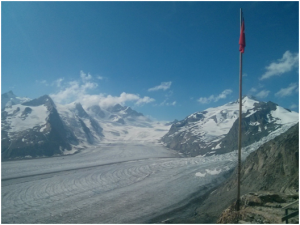 At first we were on a path over pisted snow but soon this gave way the natural snowy crust of the Jungfraufirn and a few moments later, Lonrenz led us around the edge of our first crevasse. Looking down into it there was a long wall of blue ice curving as it descended down to a dark interior. In short, not a place you’d want to find yourself! A moment later, Lorenz paused in front of me at the edge of another crevasse. Taking his axe, he cut a square foothold to step on as he made a large stride across and motioned for to me to follow him. Narrowly avoiding tangling myself in my rope, I stepped across the wide gap and turned for a moment to watch the next person cross. Feeling the rope tighten, I was away again. We weaved around and stepped across dozens of crevasses in the next hour as we descended from the Jungfraujoch towards the first junction with a tributary glacier coming down from the Fiescherhorner. We had our first break here, rewarded with the sun breaking through the cloud and the view back towards the glinting silver dome on the Sphinx at the Jungfraujoch.
At first we were on a path over pisted snow but soon this gave way the natural snowy crust of the Jungfraufirn and a few moments later, Lonrenz led us around the edge of our first crevasse. Looking down into it there was a long wall of blue ice curving as it descended down to a dark interior. In short, not a place you’d want to find yourself! A moment later, Lorenz paused in front of me at the edge of another crevasse. Taking his axe, he cut a square foothold to step on as he made a large stride across and motioned for to me to follow him. Narrowly avoiding tangling myself in my rope, I stepped across the wide gap and turned for a moment to watch the next person cross. Feeling the rope tighten, I was away again. We weaved around and stepped across dozens of crevasses in the next hour as we descended from the Jungfraujoch towards the first junction with a tributary glacier coming down from the Fiescherhorner. We had our first break here, rewarded with the sun breaking through the cloud and the view back towards the glinting silver dome on the Sphinx at the Jungfraujoch.
We set of again, this time heading out over the snow towards the rocks of one of the moraines that mark the junction of the ice from differing tributary glaciers. We walked on for another hour working our way steadily, mostly over surface snow until we reached the band of boulders and smaller rocks that have, over decades and centuries tumbled down from the sides of the Jungfrau. Here we paused and a few unharnessed themselves to be able to wander further afield and explore places where rocks sat on plinths of ice protected from thawing by their own shadows. Here we also found pools of meltwater on the ice. Lorenz was resting on an old wooden handled ice axe and explained to me that it originally belonged to his father, another Bergfuhrer, and though he has more modern ones for his climbing, this has a perfect shape for the job of cutting steps in the snow and ice to give us sure footing when crossing the crevasses.
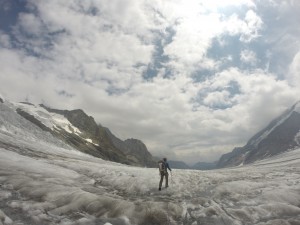 We set off again, now under blue skies with scudding clouds casting occasional shadow over us and heading along the moraine towards Konkordiaplatz, the meeting point of the tributary glaciers and the Greater Aletsch, and where the Hutte that would be our resting point sits on a rocky ledge high above the Glacier. It wasn’t always so, in fact when it was built a hundred years ago the Konkordiahutte was on a level with the top of the glaciers. However, our constant belching out of CO2 into the atmosphere means the Greater Aletsch has lost more than 125m of thickness in less than a century and this is a process that is accelerating.
We set off again, now under blue skies with scudding clouds casting occasional shadow over us and heading along the moraine towards Konkordiaplatz, the meeting point of the tributary glaciers and the Greater Aletsch, and where the Hutte that would be our resting point sits on a rocky ledge high above the Glacier. It wasn’t always so, in fact when it was built a hundred years ago the Konkordiahutte was on a level with the top of the glaciers. However, our constant belching out of CO2 into the atmosphere means the Greater Aletsch has lost more than 125m of thickness in less than a century and this is a process that is accelerating.
Hiking across ice now peppered with small stones and occasional boulders, stepping over crevasses and occasional small streams, we had adopted a rhythm and a comfortable pattern keeping our ropes above the ice but not tight, with a little slack to absorb a fall should anyone find a hidden crevasse. The ice is a beautiful blue which is particularly intensified when there is water sitting on it. It was really very mesmerising. As we strode towards the Hutte, we began to move left, leaving the rocks of the moraine to head towards the junction of the side glacier. Warm in the afternoon sunshine we paused to remove more layers and Lorenz pointed out the ‘Iron Stairs’ which climb the cliff face to the Hutte. We set off again only to be confronted a few minutes later by a fast flowing river cutting a deep gully in the ice directly across our path. Lorenz contemplated it for a few moments explored a little each way and then decided there was no crossing it so now we set off along the ice bank back out towards the centre of the glacier. Small streams kept adding to the flow so that you began to wonder how we would ever find a crossing point. However, finally after perhaps some 15 minutes, the rushing water suddenly disappeared in to a gaping hole in the ice, tumbling down into the heart of the glacier where some 900m below us these waters mix with rocks to provide the abrasive mix over which the glacier flows. Cautiously, in turn, we peered into the blue depths where the water rushes tumbling down a ‘Gletscher maure’. This was perfect for us as now we could press on again towards the base of the cliff and the looming challenge of the stairs.

Approaching the glaciers edge, the stresses in the ice mean there are more crevasses so we wove around and jumped across these until we crossed the last, at which we paused to unhitch ourselves and pack up our hiking poles. Then, thinking of the cold beer ahead, we started a scramble up the rocks until we got to the steel cable leading up to the start of the steps. At regular intervals there are wide gaps between the rock and the steel which are covered by the old wooden ladders that were the old route up the rock face. Half way up I paused to take a picture of the amazing vista of the junction of the three great glaciers each edged by the dark line of rocky moraine. Gaining my breath I started off steadily climbing until I caught up with two of my fellow wanderers at the top of the stairs where we each swapped phones and cameras to take triumphant pictures of each other with the incredible backdrop of Konkordiaplatz and the distant peak of the Jungfraujoch behind us.
We made it to the terrace of the Hutte, dropped our packs and gratefully changed our hiking boots for plastic sandals provided by our hosts before settling down at one of the tables to enjoy our well earned beers. The Hutte lies at the centre of the UNESCO world heritage site and was already busy with the Alpinists who use this spot to climb the whole range of mountains that surround it. We chatted with Lorenz about how far we’d come and how the next day would be, but most of all we revelled in the amazing views that surrounded us. He pointed out a number of peaks including the Jungfrau, Aletscherhorn and Finersteraarhorn, the closest, just across the first valley and the Truchberg or trick mountain that the first alpinists hiking from the Lötschental in bad weather had climbed in error believing they’d arrived at the Jungfrau itself.

Later we checked out our accommodation, a lovely twelve berth room with two big sleeping platforms. I staked the place closest to the door as I had a plan to be up late taking pictures of the sunset. I wandered back outside to explore a suitable spot to take a quick time lapse of the clouds racing up over the Aletsch, the Ebnefluh and distant Hollandiahutte. It went well enough until a returning alpinist disturbed it as he reached for his socks drying on the line stretched beneath the balustrade…
We might have been in the centre of a frozen world and inaccessible to most transport but there was still a 3 course meal of soup, gammon, beans and potatoes followed by a delicious cake that evening. Everything that comes here must be delivered by helicopter and, a worse thought, every piece of waste from here must also be removed by helicopter in order to maintain the pristine high Alpine environment. After dinner I grabbed my jacket and headed out to sit watch as the sky darkened and the first planet and then a few stars emerged. I also spoke to a climber taking a last breath of air before an early bed as his team were leaving at 3 am to start their ascent of the Jungfrau. As the sky finally turned black I packed my gear and found my place in the bunkroom where most of my fellow wanderers were already sleeping. Needless to say, I soon joined them.
I woke to the first sounds of movement in our room at about 5am, scrabbled to pull my hiking trousers over my leggings, and then made my way to join my party sipping hot coffee from the bowls that doubled for our birchermuesli, grabbed some cheese and bread as we made small talk, and prepared ourselves for the early hike. We got all our things together, packed our backpacks and pulled on our hiking boots and just before 6am, headed over the rocky path to the south of the Hutte, towards rosy dawn over the Eggishorn and the deep valley that marked our destination.
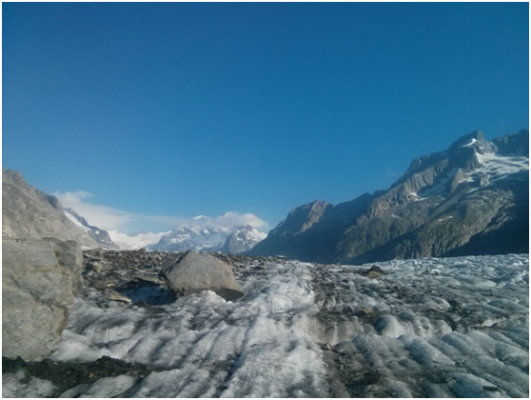
Lorenz guided us down the rocky path until we reached the icy edge of the glacier. Here he pointed to the second moraine which was the target for our first hike of the day. Here with nothing but ice and rock to walk on we would need our Eisteigers/crampons so we had a swift lesson in how to attach them and how to walk to avoid stabbing our ankles or treading on the rope between us. In the shade of the peaks the air was icy and I was so glad that I had my gloves with me. I was also very pleased to have my trekking poles to balance on as we crossed from one icy crevasse edge to another. Roped together we found our way across icy ridges and deep hollows harbouring small pools and dark layers of silt until we reached the rocky strand of the first moraine, crossing it swiftly to make our way over a furrowed surface of glinting ice and dark rocky silt. We took occasional detours to avoid crevasses with some car size boulders subsiding into their depths and before reaching the next moraine and its band of rocks we paused for some steaming berry tea we’d filled our flasks with at the Hutte. The sun was now starting to illuminate one wall of the valley and we could clearly see the curving wall of mountains that marks the edge of the Aletsch. We set off again and as we crested a rising ripple of ice, we caught our first glimpse of the Matterhorn far away on the edge of Switzerland. I couldn’t help but think of a young Tolkien who was indelibly marked by these landscapes when he made this hike in 1912 on his way to Zermatt.
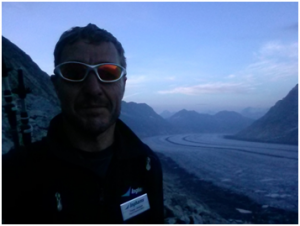 We kept to the moraine as the sun rose and with it the temperatures. At each pause we took another layer off, applied more sunblock and took another batch of photographs. Each hour of walking brought us nearer and nearer to the green sided valley at the point where the Aletsch turns east. As we came closer to the valley we left the rocky moraine and began re-crossing the wide glacier’s corrugated surface. A bank of cloud was now rolling towards us on the horizon and beginning to surround the far off Matterhorn but we were drenched in sunshine on the broad Aletsch. As we neared the edge and the glacier began its long curve, the crevasses increased in size and we passed the gaping mouths of other thankfully dry Gletshcermaules, their openings descending deep into the glacier. Passing too close to one I heard a cry of ‘Achtung’ from the colleague behind me afraid of being pulled down with it if I should clip on the smooth edge. Avoiding these meant taking a more winding path climbing high ridges of ice and descending again. The ice in places here held tempting deep blue pools undisturbed by our passing. Eventually a final climb along an ice ridge brought us to the solid rock of the edge of the glacier. As the crow flies we had covered some 12km but our meanderings had taken in far more of the surface of the 24km long greater Aletsch Glacier, the longest in continental Europe and its 27 billion tonnes of ice. Leaving it here we could unstrap the Eissteigers from our feet and give them a wash in an icy mountain stream disappearing into an ice cavern beneath the glacier. Lorenz pointed us to a crevice in the wall of rock beside us within which lay undisturbed large mineral crystals. I gathered everyone for a last group picture above the ice cave and then we began our trek out of the valley for the train ride back to the reality of life in Grindelwald, none of which will ever seem quite the same!
We kept to the moraine as the sun rose and with it the temperatures. At each pause we took another layer off, applied more sunblock and took another batch of photographs. Each hour of walking brought us nearer and nearer to the green sided valley at the point where the Aletsch turns east. As we came closer to the valley we left the rocky moraine and began re-crossing the wide glacier’s corrugated surface. A bank of cloud was now rolling towards us on the horizon and beginning to surround the far off Matterhorn but we were drenched in sunshine on the broad Aletsch. As we neared the edge and the glacier began its long curve, the crevasses increased in size and we passed the gaping mouths of other thankfully dry Gletshcermaules, their openings descending deep into the glacier. Passing too close to one I heard a cry of ‘Achtung’ from the colleague behind me afraid of being pulled down with it if I should clip on the smooth edge. Avoiding these meant taking a more winding path climbing high ridges of ice and descending again. The ice in places here held tempting deep blue pools undisturbed by our passing. Eventually a final climb along an ice ridge brought us to the solid rock of the edge of the glacier. As the crow flies we had covered some 12km but our meanderings had taken in far more of the surface of the 24km long greater Aletsch Glacier, the longest in continental Europe and its 27 billion tonnes of ice. Leaving it here we could unstrap the Eissteigers from our feet and give them a wash in an icy mountain stream disappearing into an ice cavern beneath the glacier. Lorenz pointed us to a crevice in the wall of rock beside us within which lay undisturbed large mineral crystals. I gathered everyone for a last group picture above the ice cave and then we began our trek out of the valley for the train ride back to the reality of life in Grindelwald, none of which will ever seem quite the same!
Blog & Images by Trevor Jackson, Resort Representative in Grindelwald.